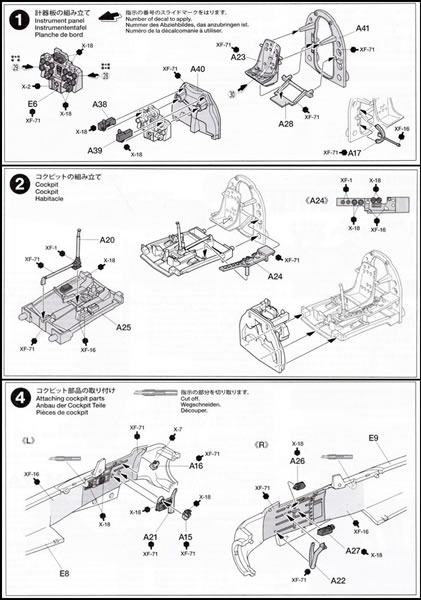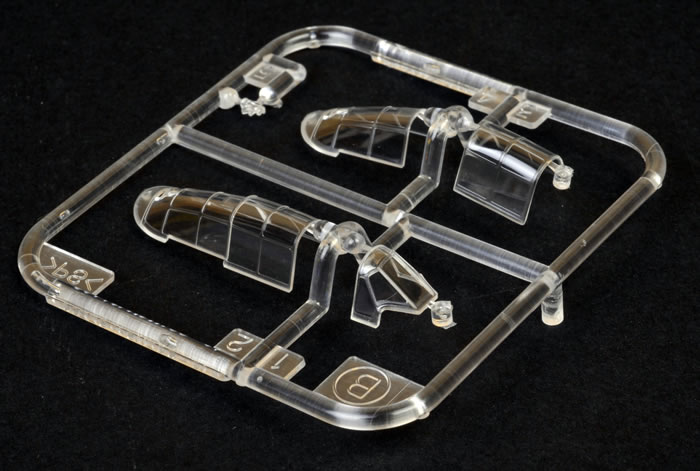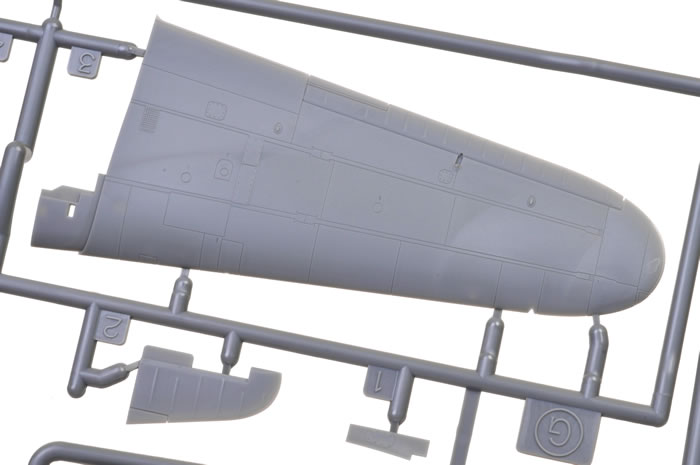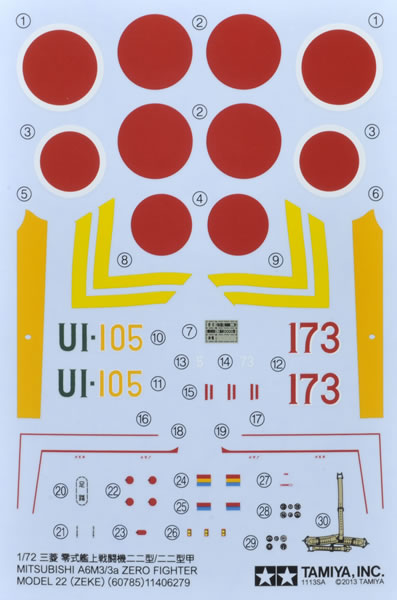|
Mitsubishi A6M3/3a Zero

Tamiya, 1/72 scale
S u m m a r y : |
Catalogue Number: |
Tamiya Kit No. 60795 Mitsubishi A6M3/3a Zero Fighter Model 22 (Zeke) |
Scale: |
1/72 |
Contents & Media |
65 grey and five clear styrene parts, two poly-caps, and decals for two subjects. |
Price: |
Available online from these and numerous other stockists worldwide:
Click here for currency conversion... |
Review Type: |
First Look |
Advantages: |
Superb quality; very good interior and exterior detail; simple but clever engineering of parts. |
Disadvantages: |
None noted. |
Conclusions: |
Some will be sick of hearing about how good Tamiya is, but there is no getting around the fact they are. Maybe not perfect; and at times closely rivalled, there is just something about the way Tamiya achieves its results in 1/72-scale whilst somehow keeping its kits simple; even when the level of detail offered means a higher than typical parts count.
Tamiya’s Zero kits are undoubtedly the best in 1/72-scale, and their Model 22 is a welcome addition to the other three versions so far kitted by them.
Highly recommended. |
Reviewed by Mark Davies

Tamiya's 1/72 scale A6M3/3a Zero is available online from Squadron.com
Background
The Mitsubishi A6M Zero was a long-range fighter aircraft, manufactured by Mitsubishi Heavy Industries, and operated by the Imperial Japanese Navy from 1940 to 1945. The A6M was designated as the Mitsubishi Navy Type 0 Carrier Fighter, and also designated as the Mitsubishi A6M Rei-sen and Mitsubishi Navy 12-shi Carrier Fighter. The A6M was usually referred to by its pilots as the "Zero-sen", zero being the last digit of the Imperial year 2600 (1940) when it entered service with the Imperial Navy. The official Allied reporting name was "Zeke", although the use of the name "Zero" was later commonly adopted by the Allies as well.
When it was introduced early in World War II, the Zero was considered the most capable carrier-based fighter in the world, combining excellent maneuverability and very long range. In early combat operations, the Zero gained a legendary reputation as a dogfighter, achieving the outstanding kill ratio of 12 to 1, but by mid-1942 a combination of new tactics and the introduction of better equipment enabled the Allied pilots to engage the Zero on generally equal terms.
The Imperial Japanese Navy Air Service ("IJNAS") also frequently used the type as a land-based fighter. By 1943, inherent design weaknesses and the failure to develop more powerful aircraft engines meant that the Zero became less effective against newer enemy fighters, which possessed greater firepower, armor, and speed, and approached the Zero's maneuverability. Although the Mitsubishi A6M was outdated by 1944, design delays and production difficulties of newer Japanese aircraft types meant that it continued to serve in a front line role until the end of the war. During the final years of the War in the Pacific, the Zero was also adapted for use in kamikaze operations. During the course of the war, Japan produced more Zeros than any other model aircraft.
Source: Wikipedia
Previous 1/72 scale Zero Kits
There have been so many previous kits of the Zero in The One True Scale that I stopped counting after reaching thirty different brands! Many of which have kitted several versions of the Zero. Some, like Airfix, Tamiya and Hasegawa, have over the years issued new toolings. Focussing on long-run kits, I think that most would agree that until Tamiya released its recent new-tool Zero kits that Hasegawa’s were the best. They had good shape and very nice surface detail but only basic interior detail.
Tamiya have released four versions of their new-tool Zero, covering four versions (Model 21, 22, 32 & 52). I could finish this review here and now in two words, by describing these kits as “Simply Superb”. But I suppose a little more is called for.
Contents
The kit comes in a quality top-opening box with excellent artwork.
The two grey sprues are enclosed in a single stapled plastic bag, with the clear sprue further protected in their own smaller bag; all with fine attachment points.
The multilingual instructions do not have a parts map, and use very well-drawn diagrams that are easy to follow. The painting and markings guide is well done in shaded monotone with four views per scheme.
Colours are described using generic names where applicable, with paint codes that correspond to the Tamiya paint range. A separate and extensive aircraft history that includes notes on the different Zero versions is provided.
The Kit
Tamiya kits stand out from all but Eduard for their comprehensive cockpit detail, and this one is no exception. Everything you could reasonably expect to see in this scale is represented, with only the seat requiring minor modification by drilling out the indented lightening holes for best appearance. Check out the accompanying scans of the instructions to see what detail is provided.

Decals are included for the instrument faces.
Some may opt for a PE harness, but I have found that Tamiya’s decal harnesses can be quite convincing if you do not use them as a decal. I find that it is best to cut the decal out with its paper backing left in place. The white backing must then be suitably coloured to match the front face. This process gives some “meat” to the harness, and allows it to be draped and folded into the seat. The edges can be shadowed with a wash. The overall effect is far superior to the very flat and undernourished look that results from applying the decal directly to the seat.
Another nice touch is the way the cockpit sub-assembly can be fitted after the fuselage halves have been joined and any seam-sanding completed.
The clear parts provide a very nice clear and thin canopy, with optional parts for open and closed alternatives, as well as a detailed gunsight.

The engine is most convincing, with good shape to the cylinders and their heads, and very fine cooling fin detail. In this scale the integrally moulded pushrods are quite acceptable. The engine halves enclose a poly-cap to grip the propeller shaft. The engine is enclosed by a very cleanly moulded cowl with its cooling gills closed. A separate and cleverly engineered oil cooler fits behind the cowl on the fuselage underside. The prop and spinner finish this area off.
The wings feature convincingly deep and nicely detail wheel wells. There are panels that fit in the outer portions of the lower wing half due to mould sharing with another boxing. The tailplane, like the wings, has all control surfaces in the neutral position; and although the rudder is separate, it too is designed fit in the neutral position.

The undercarriage is nicely rendered, and includes the retraction linkages for the small inboard doors. Not much remains to mention as only small parts are left to fit. These include and arrestor-hook, antenna mast, cannon barrels, pitot, what I think are a form of aileron mass-balance, and finally, the drop-tank.
Tamiya quality may seem to be a bit of a cliché, but just looking at this kit in the box shows why this brand’s products remain unsurpassed, despite being very closely approached, or even perhaps equaled in the case of Eduard’s 1/48 Spitfire Mk IX. Certainly, in 1/72 scale, it is hard to think of an injected kit that betters this one in the way it combines clever engineering, superb detail, yet simple assembly despite a comparatively high parts count. It goes without saying that I would expect this kit to be extremely easy to build.
Colour and Markings
Two colour scheme options are provided for, these being:
-
Major Saburo Shindo’s aircraft, of the 582nd Naval Air Group, Buin, Bougainville, June 1943; and
-
An aircraft of the 251st Naval Air Group, the Solomons, May 1943.

The kit decals look to be excellent. I recently used the Tamiya kit decals and found them to be excellent to apply, so I should think these ones will be too.
Some will be sick of hearing about how good Tamiya is, but there is no getting around the simple fact that they are. Maybe not perfect, and at times closely rivalled; there is just something about the way Tamiya achieves its results in 1/72-scale whilst somehow keeping its kits simple; even when the level of detail offered means a higher than typical parts count.
Tamiya’s Zero kits are undoubtedly the best in 1/72-scale, and their Model 22 is a welcome addition to the other three versions so far kitted by them.
Highly Recommended.
Thanks to Tamiya for the sample.
Review Text
Copyright © 2014 by Mark Davies
Images Copyright © 2014 by Brett Green
Page Created 24 April, 2014
Last updated
24 April, 2014
Back to HyperScale Main Page
Back to Reviews Page

|
